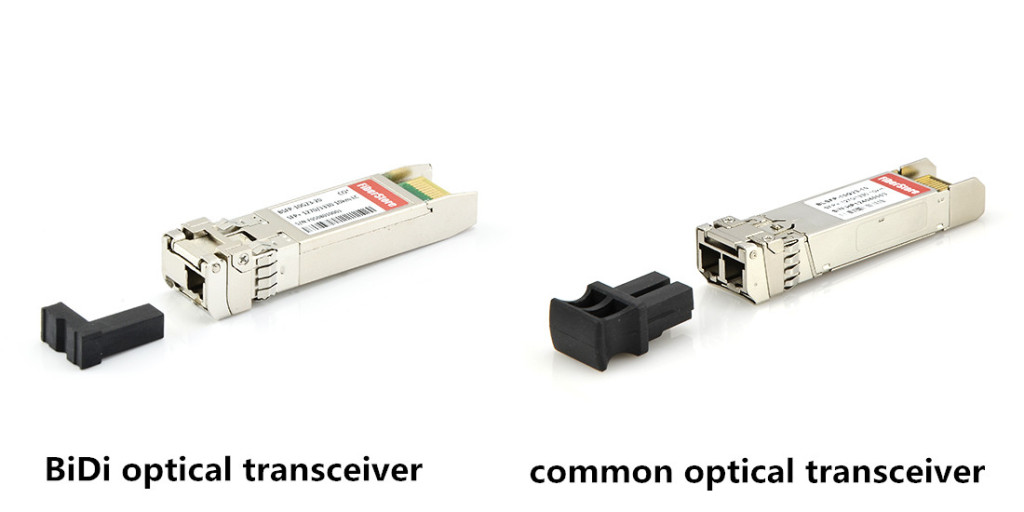In each and every data center and IT infrastructure, the demand for larger capacity, higher bandwidth and more reliable performance will never slack. Meanwhile, your applications and competitive advantages increasingly depend on it. Which may explain why nowadays migrating from 10G to 40G has become a popular and vital option for many service providers. This article will briefly introduce bidirectional (BiDi) transceiver—a cost-effective and feasible solution to bring 40-Gbps speeds to the access layer.
Introduction to BiDi Transceiver
BiDi transceiver, also known as bidirectional transceiver, usually consists of two different wavelengths to achieve transmission in both directions on just one fiber (single-mode or multi-mode). Unlike general optical transceivers which have two ports, BiDi transceivers have only one port. With wavelength division multiplexing (WDM) technology, BiDi transceiver enables the signal to be sent and received in both directions by different center wavelength. The most frequently used wavelength of BiDi optical module is 1310nm/1550nm, 1310nm/1490nm, 1510nm/1590nm. From the picture shown below, it is easy to distinguish BiDi transceiver from the general one.

Working Principle of BiDi Transceiver
The major difference between BiDi transceivers and general transceivers lies in the fact that BiDi transceivers are equipped with WDM couplers, which combine and separate data transmitted over a single fiber based on the wavelengths of the light. The following picture clearly illustrates how BiDi transceivers work. The two wavelengths that have been used in this example are 1310nm and 1490nm. Usually the upstream transmits at the shorter wavelength, while the downstream at the longer wavelength. What should be addressed is that BiDi transceivers must be deployed in pairs, so that the diplexers could turn to match the expected wavelength of the transmitter and receiver transmitting data.

What Can BiDi Transceiver Achieve
- 40G connectivity becomes more reliable with BiDi transceiver technology. Your servers need it, your applications and users demand it, and your competitors are working to deliver it.
- BiDi transceiver can reduce the cost in fiber cabling infrastructure since it requires less fiber cable and less fiber patch panels. On the other hand, BiDi transceiver also makes it possible to save more precious space in data centers.
QSFP BiDi Transceiver Solution
There exist three types commonly used BiDi transceivers: BiDi SFP+ transceivers, BiDi XFP transceivers and QSFP BiDi transceivers. As BiDi SFP+ transceivers and BiDi XFP transceivers are designed for bidirectional 10G serial optical data communications, QSFP BiDi transceivers allow reuse of existing 10G fiber infrastructure for 40G connections. In this part, we will discuss QSFP BiDi transceiver in detail.
40G QSFP BiDi transceiver has two 20G channels, each transmitted and received simultaneously on two wavelength over a single MMF strand (OM3 or OM4). It allows the existing 10G cabling system to be repurposed for 40G connectivity. Which means it lets you bring 40G speeds to the access layer using the same 10G cable plant you are using today. In contrast, the general QSFP SR4 transceiver like Cisco QSFP-40G-SR4 requires new patch cables and patch panels since the connector types differ and the size of the fiber trunk needs to be quadrupled.

The QSFP-40G-SR-BD transceiver transmits full-duplex 40G traffic over one dual-fiber LC-connector OM3 or OM4 MMF cable. It is capable of reusing 10G fiber infrastructure. That’s to say it enables data center operators to upgrade to 40G connectivity without making any changes to the previous 10G fiber cable plant. It is a huge cost savings, whether you are upgrading your current data center or building a new one. And it means you can start taking advantage of 40G performance for your organization right now.
Conclusion
BiDi transceiver serves as an ideal and feasible solution in situations where only limited fibers or limited conduit space is available. And the deployment of BiDi transceivers efficiently enhances the bandwidth capacity of the existing optical fiber infrastructure and help to achieve economical and reliable performance of the optical network.

No comments:
Post a Comment